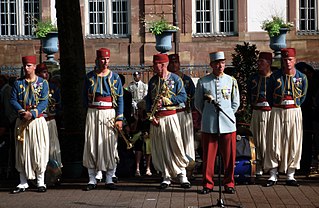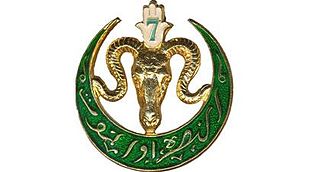History
The 2nd Moroccan Division was created on 4 August 1918, following the dissolution of the 65th Infantry Division, and was commanded by General Louis Pierre M Antoine Modelon.
The division participated in the Second Battle of the Somme and advanced towards the Quennevières and Puisaleine farms. On 26 August, it advanced further towards Crécy-au-Mont, crossing the Ailette river and pushing towards the Hindenburg line until 5 September. It then took part in the End offensive and advanced into Germany after the Armistice, reaching the Rhine on 21 November 1918.
On 25 March 1919, the Division was disbanded.

A tirailleur, in the Napoleonic era, was a type of light infantry trained to skirmish ahead of the main columns. Later, the term "tirailleur" was used by the French Army as a designation for indigenous infantry recruited in the French colonial territories during the 19th and 20th centuries, or for metropolitan units serving in a light infantry role.

The Senegalese Tirailleurs were a corps of colonial infantry in the French Army. They were initially recruited from Senegal, French West Africa and subsequently throughout Western, Central and Eastern Africa: the main sub-Saharan regions of the French colonial empire. The noun tirailleur, which translates variously as 'skirmisher', 'rifleman', or 'sharpshooter', was a designation given by the French Army to indigenous infantry recruited in the various colonies and overseas possessions of the French Empire during the 19th and 20th centuries.

The 1st Foreign Cavalry Regiment is the only cavalry regiment of the Foreign Legion in the French Army. It is one of two armoured cavalry regiments of the 6th Light Armoured Brigade.

The Army of Africa was an unofficial but commonly used term for those portions of the French Army stationed in French North Africa from 1830 until the end of the Algerian War in 1962, including the French units made up of indigenous recruits.
The 19th Army Corps was a corps of the French army. In December 1870, the Tours delegation created the 19th Army Corps which was formed in Alençon. It was recreated by decree of the JO of August 13, 1874, it brought together the various military units of Algeria. It constituted the nucleus of the Army of Africa.

The 3rd Algerian Infantry Division was an infantry division of the Army of Africa which participated in World War II.

The Régiment d'infanterie chars de marine RICM in French, is a light cavalry regiment of the French Army, successor to the Régiment d'infanterie coloniale du Maroc RICM.

The Tonkin Expeditionary Corps was an important French military command based in northern Vietnam (Tonkin) from June 1883 to April 1886. The expeditionary corps fought the Tonkin Campaign (1883–86) taking part in campaigns against the Black Flag Army and the Chinese Yunnan and Guangxi Armies during the Sino-French War and the period of undeclared hostilities that preceded it, and in important operations against Vietnamese guerrilla bands during the subsequent 'Pacification of Tonkin'.

The 1st Marine Infantry Regiment is a French regiment heir of the colonial infantry. The regiment is one of the « quatre vieux » regiments of the Troupes de Marine, with the 2nd Marine Infantry Regiment 2e RIMa, the 3rd Marine Infantry Regiment 3e RIMa, as well the 4th Marine Infantry Regiment 4e RIMa. Along with the 1st Marine Artillery Regiment 1e RAMa and the 2nd Marine Artillery Regiment 2e RAMa, the 1st Marine formed the Blue Division. The 1e RIMa is a light armoured unit, since 1986, alike with the régiment d'infanterie-chars de marine RICM.

General Noël Marie Amédée Garnier-Duplessix or Duplessis was a French army officer. Whilst still a colonel he commanded the 2nd Infantry Division in the Allied victory at the First Battle of the Marne before seeing service in the Zaian War in the French protectorate of Morocco. Garnier-Duplessix returned to France in October 1916 and received command of the 37th Infantry Division for the 15 December offensive of the Battle of Verdun and the Nivelle Offensive of April 1917. He received command of the 9th Army Corps in June 1918 and led that unit to victory in the August Battle of Amiens and the autumn Meuse-Argonne Offensive. After the war he was posted to Cilicia in the Franco-Turkish War of 1918–21 where he argued against early withdrawal of troops following the March 1921 Cilicia Peace Treaty.

The Marching Regimentof the Foreign Legion (RMLE) was a French military unit that fought in World War I and World War II. Initially composed of marching regiments from the 1st Foreign Regiment of Sidi Bel Abbes and the 2nd Foreign Infantry Regiment of Saida, Algeria, it re-formed as the 3rd Foreign Infantry Regiment.
The Moroccan Division or the 1st Moroccan Division of 1914, initially the Marching Division of Morocco was an infantry division of France's Army of Africa which participated in World War I.

The 1st Moroccan Division created on October 27, 1939 was an infantry division of the Army of Africa which participated in the Battle of France during World War II.

The 4th Tunisian Tirailleurs Regiment was an infantry regiment of the Army of Africa, part of the French Army.

The 7th Algerian Tirailleurs Regiment was an infantry unit of the French Army, part of the Army of Africa.

The 3rd Algerian Tirailleurs Regiment was an infantry unit of the Army of Africa in the French Army. Recruited primarily from Algerian Muslims, it was mainly commanded by French officers. The racial boundaries were not absolute, with some French volunteers serving in the ranks and a limited number of Muslims being appointed as officers. After 1913 a selective form of conscription was applied to Algerian Muslims but the majority of Muslim soldiers serving in the 3e R.T.A continued to be voluntarily enlisted.

The 4th Moroccan Mountain Division was an infantry division of the Army of Africa which participated in World War II.

The 2nd Moroccan Infantry Division was an infantry division of the Army of Africa which participated in World War II.
156th Infantry Division was an infantry division of the French Army during the First World War. It was deployed overseas, seeing action during the Gallipoli campaign, and thereafter on the Salonika front, fighting alongside British troops in both theatres of war. It was sent to the Crimea in December 1918 as part of the Army of the Danube.
17th Colonial Infantry Division was an infantry division of the French Army during the First World War. It was deployed overseas, seeing action during the Gallipoli campaign, and thereafter on the Salonika front, fighting alongside British troops in both theatres of war. It was sent to the Crimea in December 1918 as part of the Army of the Danube.
This page is based on this
Wikipedia article Text is available under the
CC BY-SA 4.0 license; additional terms may apply.
Images, videos and audio are available under their respective licenses.















